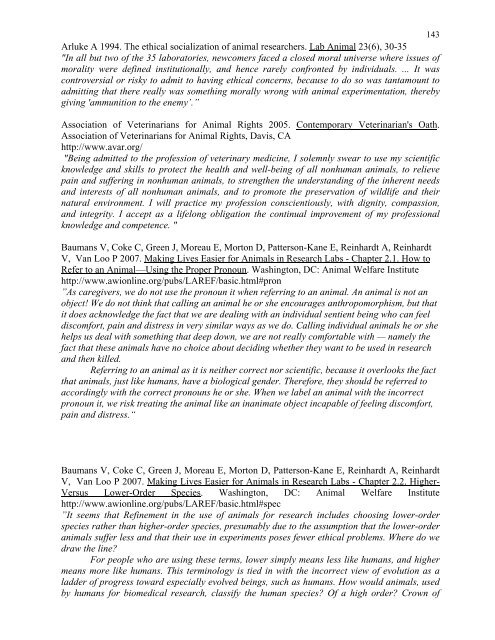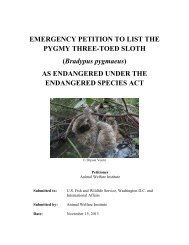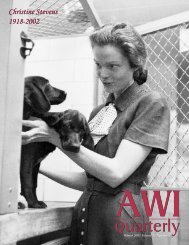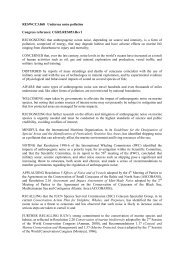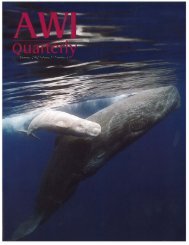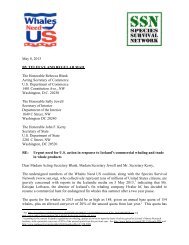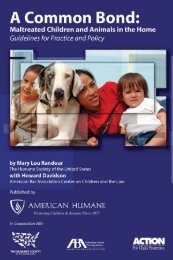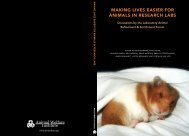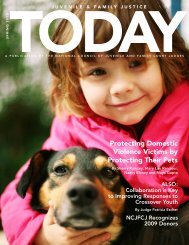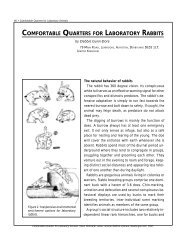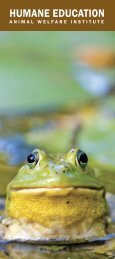143Arluke A 1994. The ethical socialization of animal researchers. Lab Animal 23(6), 30-35"In all but two of the 35 laboratories, newcomers faced a closed moral universe where issues ofmorality were defined institutionally, a<strong>nd</strong> hence rarely confronted by i<strong>nd</strong>ividuals. ... It wascontroversial or risky to admit to having ethical concerns, because to do so was tantamount toadmitting that there really was something morally wrong with animal experi<strong>ment</strong>ation, therebygiving 'ammunition to the enemy’.”Association of Veterinarians <strong>for</strong> Animal Rights 2005. Contemporary Veterinarian's Oath.Association of Veterinarians <strong>for</strong> Animal Rights, Davis, CAhttp://www.avar.org/"Being admitted to the profession of veterinary medicine, I solemnly swear to use my scientificknowledge a<strong>nd</strong> skills to protect the health a<strong>nd</strong> well-being of all nonhuman animals, to relievepain a<strong>nd</strong> suffering in nonhuman animals, to strengthen the u<strong>nd</strong>ersta<strong>nd</strong>ing of the inherent needsa<strong>nd</strong> interests of all nonhuman animals, a<strong>nd</strong> to promote the preservation of wildlife a<strong>nd</strong> theirnatural environ<strong>ment</strong>. I will practice my profession conscientiously, with dignity, compassion,a<strong>nd</strong> integrity. I accept as a lifelong obligation the continual improve<strong>ment</strong> of my professionalknowledge a<strong>nd</strong> competence. "Baumans V, Coke C, Green J, Moreau E, Morton D, Patterson-Kane E, <strong>Re</strong>inhardt A, <strong>Re</strong>inhardtV, Van Loo P 2007. Making Lives Easier <strong>for</strong> Animals in <strong>Re</strong>search Labs - Chapter 2.1. How to<strong>Re</strong>fer to an Animal—Using the Proper Pronoun. Washington, DC: Animal Welfare Institutehttp://www.awionline.org/pubs/LAREF/basic.html#pron”As caregivers, we do not use the pronoun it when referring to an animal. An animal is not anobject! We do not think that calling an animal he or she encourages anthropomorphism, but thatit does acknowledge the fact that we are dealing with an i<strong>nd</strong>ividual sentient being who can feeldiscom<strong>for</strong>t, pain a<strong>nd</strong> distress in very similar ways as we do. Calling i<strong>nd</strong>ividual animals he or shehelps us deal with something that deep down, we are not really com<strong>for</strong>table with — namely thefact that these animals have no choice about deciding whether they want to be used in researcha<strong>nd</strong> then killed.<strong>Re</strong>ferring to an animal as it is neither correct nor scientific, because it overlooks the factthat animals, just like humans, have a biological ge<strong>nd</strong>er. There<strong>for</strong>e, they should be referred toaccordingly with the correct pronouns he or she. When we label an animal with the incorrectpronoun it, we risk treating the animal like an inanimate object incapable of feeling discom<strong>for</strong>t,pain a<strong>nd</strong> distress.“Baumans V, Coke C, Green J, Moreau E, Morton D, Patterson-Kane E, <strong>Re</strong>inhardt A, <strong>Re</strong>inhardtV, Van Loo P 2007. Making Lives Easier <strong>for</strong> Animals in <strong>Re</strong>search Labs - Chapter 2.2. Higher-Versus Lower-Order Species. Washington, DC: Animal Welfare Institutehttp://www.awionline.org/pubs/LAREF/basic.html#spec”It seems that <strong>Re</strong><strong>finem</strong>ent in the use of animals <strong>for</strong> research includes choosing lower-orderspecies rather than higher-order species, presumably due to the assumption that the lower-orderanimals suffer less a<strong>nd</strong> that their use in experi<strong>ment</strong>s poses fewer ethical problems. Where do wedraw the line?For people who are using these terms, lower simply means less like humans, a<strong>nd</strong> highermeans more like humans. This terminology is tied in with the incorrect view of evolution as aladder of progress toward especially evolved beings, such as humans. How would animals, usedby humans <strong>for</strong> biomedical research, classify the human species? Of a high order? Crown of
144creation? Very unlikely!I think all animals deserve the same consideration, whether they are a rat ormouse — of presumed low order — or a dog or monkey — of presumed higher order. It seemsstrange to me to categorize animals into different orders a<strong>nd</strong> then treat them accordingly.“Canadian Council on Animal Care, Olfert ED, Cross BM, McWilliam AA 1993. Guide to theCare a<strong>nd</strong> Use of Experi<strong>ment</strong>al Animals, Volume 1, 2<strong>nd</strong> Edition. Canadian Council on AnimalCare, Ottawa, ONhttp://www.ccac.ca/en/CCAC_Programs/Guidelines_Policies/GUIDES/ENGLISH/toc_v1.htm"We are morally responsible <strong>for</strong> any living thing that we cause to be depe<strong>nd</strong>ent upon us,including animals used in research, teaching a<strong>nd</strong> testing."Halpern-Lewis JG 1996. U<strong>nd</strong>ersta<strong>nd</strong>ing the emotional experiences of animal research personnel.Contemporary Topics in Laboratory Animal Science 35(6), 58-60"Animal research personnel should be encouraged to join in the pursuit of progress with therecognition that, in addition to knowledge a<strong>nd</strong> skills, primary attributes must be feelings ofcompassion a<strong>nd</strong> sensitivity toward animals. Because animals cannot speak <strong>for</strong> themselves, it isup to empathetic a<strong>nd</strong> caring personnel to see that they are treated humanely a<strong>nd</strong> with respect. Avariety of suggestions have been provided to enable research participants to per<strong>for</strong>m necessarytasks without impeding experi<strong>ment</strong>al results or detracting from the integrity of the animal-humanrelationship. It is my belief that i<strong>nd</strong>ividuals who demonstrate caring behaviors while beingallowed appropriate outlets <strong>for</strong> expression will remarkably enrich the overall researchexperience of humans a<strong>nd</strong> animals alike."Herzog H 2002. Ethical aspects of relationships between humans a<strong>nd</strong> research animals. ILAR[Institute <strong>for</strong> Laboratory Animal <strong>Re</strong>search] Journal 43(1), 27-32http://dels.nas.edu/ilar_n/ilarjournal/43_1/Ethical.shtml"More often than not, moral dilemmas are the result of good people trying to do the right thingwhen the right thing is unclear. ... I have spoken with some animal care staff who havecomplained about investigators who rarely set foot in their institution's animal colony a<strong>nd</strong> whoappear to regard research animals as organ repositories. In addition, some researchers showlittle u<strong>nd</strong>ersta<strong>nd</strong>ing of the ethical problems faced by technicians. ... There is every reason tobelieve that i<strong>nd</strong>ividuals who care about their wards on a personal level actually treat theanimals better. .. Inevitably, i<strong>nd</strong>ividuals who work with animals in the context of biomedical a<strong>nd</strong>behavioral research will sometimes <strong>for</strong>m bo<strong>nd</strong>s with the animals with whom they interact. Whenan animal is trans<strong>for</strong>med from ‘object’ to ‘pet,’ its moral status is changed. Although humanresearchanimal relationships may enhance the well-being of laboratory animals, they involve amoral cost to the human caretakers. Institutions should acknowledge the existence of these bo<strong>nd</strong>sa<strong>nd</strong> provide support mechanisms to help laboratory personnel deal with the moral challenges oftheir profession.”Mroczek NS 1994. <strong>Re</strong>cognizing animal suffering a<strong>nd</strong> pain. Lab Animal 23(1), 27-31Highlights the "human co<strong>nd</strong>itioning to the incongruous position that considers animalsdissimilar to humans with respect to drive, need, or sensation, yet similar enough to be used asmodels <strong>for</strong> the study of humans themselves. ... Identification, sympathy, a<strong>nd</strong> positive regard by ascientist or animal care worker can, most of all, help to encourage optimum care a<strong>nd</strong> treat<strong>ment</strong>of animals in pain. <strong>Re</strong>cognition of animals suffering a<strong>nd</strong> pain is made possible by feeling <strong>for</strong> a<strong>nd</strong>interest in animals themselves, as sentient organisms, first a<strong>nd</strong> <strong>for</strong>emost, a<strong>nd</strong> feeling <strong>for</strong> a<strong>nd</strong>interest in animal behavior in totality."
- Page 3:
Table of ContentsSpecies-typical Be
- Page 7 and 8:
2Behavioral Pathologies (Abnormal B
- Page 9 and 10:
Meyerson BJ 1986. Ethology in anima
- Page 11 and 12:
6"An animal treated unsympathetical
- Page 13 and 14:
8"If sufficient room is not provide
- Page 15 and 16:
Canadian Council on Animal Care 198
- Page 17 and 18:
12Platt DM, Kinsey JH, Jorgenson MJ
- Page 19 and 20:
14(7) Enforced RestraintAdams MR, K
- Page 21 and 22:
16Goosen DJ, Davies JH, Maree M, Do
- Page 23 and 24:
Norman RL, McGlone J, Smith CJ 1994
- Page 25 and 26:
20Crockett CM, Bowers CL, Shimoji M
- Page 27 and 28:
22(10) Double-tier Cage Arrangement
- Page 29 and 30:
National Research Council 1998. The
- Page 31 and 32:
26Coe CL 1991. Is social housing of
- Page 33 and 34:
28Tatoyan SK, Cherkovich GM 1972. T
- Page 35 and 36:
30Line SW, Morgan KN, Markowitz H,
- Page 37 and 38:
32Reinhardt V 1989. Evaluation of t
- Page 39 and 40:
34Clarke AS, Juno CJ, Maple TL 1982
- Page 41 and 42:
36The animals “spent most time in
- Page 43 and 44:
38Brent L, Belik M 1997. The respon
- Page 45 and 46:
40"Access to the puzzles was accomp
- Page 47 and 48:
42"The purpose of this study was to
- Page 49 and 50:
44Choi GC 1993. Humans enrich the l
- Page 51 and 52:
46“Eleven baboons who had been si
- Page 53 and 54:
48Reinhardt V, Houser WD, Eisele S,
- Page 55 and 56:
50Thompson MA, Bloomsmith MA, Taylo
- Page 57 and 58:
(7) Working with Cooperative Animal
- Page 59 and 60:
54Lambeth SP, Hau J, Perlman JE, Ma
- Page 61 and 62:
56Smith M, Barley J, Down N, Franci
- Page 63 and 64:
Environmental Enrichment58(1) Defin
- Page 65 and 66:
60Baker KC, Seres M, Aureli F, de W
- Page 67 and 68:
62Judge PG, de Waal BM, Paul KS, Go
- Page 69 and 70:
(2,1,b) Group-housing: Group Format
- Page 71 and 72:
66McNary JK 1992. Integration of ch
- Page 73 and 74:
68Clarke MR, Blanchard JL 1994. All
- Page 75 and 76:
Watts E 1997. Introductions. In Ora
- Page 77 and 78:
72Baumans V, Coke C, Green J, Morea
- Page 79 and 80:
74Hotchkiss CE, Paule MG 2003. Effe
- Page 81 and 82:
76Reinhardt V, Hurwitz S 1993. Eval
- Page 83 and 84:
78Shively CA 2001. Psychological we
- Page 85 and 86:
80“The establishment of dominance
- Page 87 and 88:
82Reinhardt V 1991. Agonistic behav
- Page 89 and 90:
Abney D, Conlee K, Cunneen M, Down
- Page 91 and 92:
86Boccia ML, Broussard C, Scanlan J
- Page 93 and 94:
Southey ER, Baldwin CM 2006. Social
- Page 95 and 96:
T-W-Fiennes RN 1972. Primates - Gen
- Page 97 and 98: 927 to 44 training sessions. .. The
- Page 99 and 100: 94Baumans V, Coke C, Green J, Morea
- Page 101 and 102: 96Skoumbourdis EK 2008. Pole-and-co
- Page 103 and 104: 98Tamarins (Saguinus spp.)Smith TE,
- Page 105 and 106: 100Bertrand F, Seguin Y, Chauvier F
- Page 107 and 108: 102Gilloux I, Gurnell J, Shepherdso
- Page 109 and 110: 104Molzen EM, French JA 1989. The p
- Page 111 and 112: 106Reinhardt V 1992. Foraging for c
- Page 113 and 114: 108Boccia ML 1989. Long-term effect
- Page 115 and 116: 110Baumans V, Coke C, Green J, More
- Page 117 and 118: 112”We give our pair-housed cynos
- Page 119 and 120: 114use their hands to obtain and pr
- Page 121 and 122: 116MacLean E, Roberts Prior S 2006.
- Page 123 and 124: Bayne K, Hurst JK, Dexter SL 1992.
- Page 125 and 126: 120Phillippi-Falkenstein K 1998. Us
- Page 127 and 128: 122Shimoji M, Bowers CL, Crockett C
- Page 129 and 130: Anonymous 1991. The psychological w
- Page 131 and 132: 126Pruetz JD, Bloomsmith MA 1992. C
- Page 133 and 134: 128Reinhardt V 1990. Time budget of
- Page 135 and 136: 130O'Neill PL, Wright AC, Weed JL 1
- Page 137 and 138: 132above ground level. I very often
- Page 139 and 140: 134Canadian Council on Animal Care
- Page 141 and 142: 136International Primatological Soc
- Page 143 and 144: 138forage daily, by scattering food
- Page 145 and 146: 140sensory and emotional experience
- Page 147: 142Bayne K 1989 Resolving issues of
- Page 151: 146Spaeth GL 1994. Editorial: Carin


